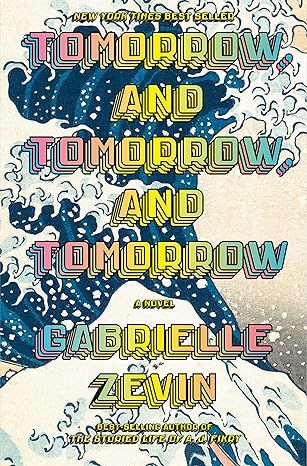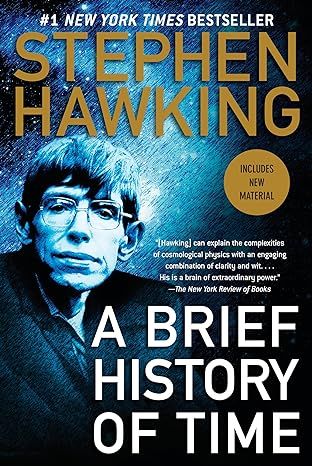A Brief History of Time
4.7
-
5,104 ratings
A Brief History of Time: From the Big Bang to Black Holes is a book on theoretical cosmology by English physicist Stephen Hawking. It was first published in 1988. Hawking wrote the book for readers who had no prior knowledge of physics.
In A Brief History of Time, Hawking writes in non-technical terms about the structure, origin, development and eventual fate of the Universe, which is the object of study of astronomy and modern physics. He talks about basic concepts like space and time, basic building blocks that make up the Universe (such as quarks) and the fundamental forces that govern it (such as gravity). He writes about cosmological phenomena such as the Big Bang and black holes. He discusses two major theories, general relativity and quantum mechanics, that modern scientists use to describe the Universe. Finally, he talks about the search for a unifying theory that describes everything in the Universe in a coherent manner.
The book became a bestseller and sold more than 25 million copies.
#1 NEW YORK TIMES BESTSELLER
A landmark volume in science writing by one of the great minds of our time, Stephen Hawking’s book explores such profound questions as: How did the universe begin—and what made its start possible? Does time always flow forward? Is the universe unending—or are there boundaries? Are there other dimensions in space? What will happen when it all ends?
Told in language we all can understand, A Brief History of Time plunges into the exotic realms of black holes and quarks, of antimatter and “arrows of time,” of the big bang and a bigger God—where the possibilities are wondrous and unexpected. With exciting images and profound imagination, Stephen Hawking brings us closer to the ultimate secrets at the very heart of creation.
School & Library Binding
$34.70
Paperback
$9.99
Ships from
Amazon.com
Payment
Secure transaction
ASIN
0553380168
ISBN-10
9780553380163
ISBN-13
978-0553380163
Print length
212 pages
Language
English
Publisher
Random House Publishing Group
Publication date
September 01, 1998
Dimensions
5.94 x 0.65 x 8.95 inches
Item weight
2.31 pounds
Editorial Reviews
“[Hawking] can explain the complexities of cosmological physics with an engaging combination of clarity and wit. . . . His is a brain of extraordinary power.”—The New York Review of Books
“This book marries a child’s wonder to a genius’s intellect. We journey into Hawking’s universe while marvelling at his mind.”—The Sunday Times (London)
“Masterful.”—The Wall Street Journal
“Charming and lucid . . . [A book of] sunny brilliance.”—The New Yorker
“Lively and provocative . . . Mr. Hawking clearly possesses a natural teacher’s gifts—easy, good-natured humor and an ability to illustrate highly complex propositions with analogies plucked from daily life.”—The New York Times
“Even as he sits helpless in his wheelchair, his mind seems to soar ever more brilliantly across the vastness of space and time to unlock the secrets of the universe.”—Time
Sample
Chapter 1
OUR PICTURE OF THE UNIVERSE
A well-known scientist (some say it was Bertrand Russell) once gave a public lecture on astronomy. He described how the earth orbits around the sun and how the sun, in turn, orbits around the center of a vast collection of stars called our galaxy. At the end of the lecture, a little old lady at the back of the room got up and said: “What you have told us is rubbish. The world is really a flat plate supported on the back of a giant tortoise.” The scientist gave a superior smile before replying, “What is the tortoise standing on?” “You’re very clever, young man, very clever,” said the old lady. “But it’s turtles all the way down!”
Most people would find the picture of our universe as an infinite tower of tortoises rather ridiculous, but why do we think we know better? What do we know about the universe, and how do we know it? Where did the universe come from, and where is it going? Did the universe have a beginning, and if so, what happened before then? What is the nature of time? Will it ever come to an end? Can we go back in time? Recent breakthroughs in physics, made possible in part by fantastic new technologies, suggest answers to some of these longstanding questions. Someday these answers may seem as obvious to us as the earth orbiting the sun–or perhaps as ridiculous as a tower of tortoises. Only time (whatever that may be) will tell.
As long ago as 340 B.C. the Greek philosopher Aristotle, in his book On the Heavens, was able to put forward two good arguments for believing that the earth was a round sphere rather than a flat plate. First, he realized that eclipses of the moon were caused by the earth coming between the sun and the moon. The earth’s shadow on the moon was always round, which would be true only if the earth was spherical. If the earth had been a flat disk, the shadow would have elongated and elliptical, unless the eclipse always occurred at a time when the sun was directly under the center of the disk. Second, the Greeks knew from their travels that the North Star appeared lower in the sky when viewed in the south than it did in more northerly regions. (Since the North Star lies over the North Pole, it appears to be directly above an observer at the North Pole, but to someone looking from the equator, it appears to lie just at the horizon. From the difference in the apparent position of the North Star in Egypt and Greece, Aristotle even quoted an estimate that the distance around the earth was 400,000 stadia. It is not known exactly what length a stadium was, but it may have been about 200 yards, which would make Aristotle’s estimate about twice the currently accepted figure. The Greeks even had a third argument that the earth must be round, for why else does one first see the sails of a ship coming over the horizon, and only later see the hull?
Aristotle thought the earth was stationary and that the sun, the moon, the planets, and the stars moved in circular orbits about the earth. He believed this because he felt, for mystical reasons, that the earth was the center of the universe, and that circular motion was the most perfect. This idea was elaborated by Ptolemy in the second century A.D. into a complete cosmological model. The earth stood at the center, surrounded by eight spheres that carried the moon, the sun, the stars, and the five planets known at the time, Mercury, Venus, Mars, Jupiter, and Saturn (Fig 1.1). The planets themselves moved on smaller circles attached to their respective spheres in order to account for their rather complicated observed paths in the sky. The outermost sphere carried the so-called fixed stars, which always stay in the same positions relative to each other but which rotate together across the sky. What lay beyond the last sphere was never made very clear, but it certainly was not part of mankind’s observable universe.
Ptolemy’s model provided a reasonably accurate system for predicting the positions of heavenly bodies in the sky. But in order to predict these positions correctly, Ptolemy had to make an assumption that the moon followed a path that sometimes brought it twice as close to the earth as at other times. And that meant that the moon ought sometimes to appear twice as big as at other times! Ptolemy recognized this flaw, but nevertheless his model was generally, although not universally, accepted. It was adopted by the Christian church as the picture of the universe that was in accordance with Scripture, for it had the great advantage that it left lots of room outside the sphere of fixed stars for heaven and hell.
Read more
About the authors
Stephen Hawking
Stephen Hawking's ability to make science understandable and compelling to a lay audience was established with the publication of his first book, A Brief History of Time, which has sold nearly 10 million copies in 40 languages. Hawking has authored or participated in the creation of numerous other popular science books, including The Universe in a Nutshell, A Briefer History of Time, On the Shoulders of Giants, The Illustrated On the Shoulders of Giants, and George's Secret Key to the Universe.
(Stephen William Hawking; Oxford, Reino Unido, 8 de Enero de 1942 - Cambridge, 14 de marzo de 2018) Físico teórico británico. A pesar de sus discapacidades físicas y de las progresivas limitaciones impuestas por la enfermedad degenerativa que padecía, Stephen William Hawking es probablemente el físico más conocido entre el gran público desde los tiempos de Einstein. Luchador y triunfador, a lo largo de toda su vida logró sortear la inmensidad de impedimentos que le planteó el mal de Lou Gehrig, una esclerosis lateral amiotrófica que le aquejaba desde que tenía 20 años. Hawking es, sin duda, un ejemplo particular de vitalidad y resistencia frente al infortunio del destino.
Fue miembro de la Real Sociedad de Londres, de la Academia Pontificia de las Ciencias y de la Academia Nacional de Ciencias de Estados Unidos. Fue titular de la Cátedra Lucasiana de Matemáticas (Lucasian Chair of Mathematics) de la Universidad de Cambridge desde 1979 hasta su jubilación en 2009. Entre las numerosas distinciones que le han sido concedidas, Hawking ha sido honrado con doce doctorados honoris causa y ha sido galardonado con la Orden del Imperio Británico (grado CBE) en 1982, el Premio Príncipe de Asturias de la Concordia en 1989, la Medalla Copley en 2006, la Medalla de la Libertad en 2009 y el Premio Fundación BBVA Fronteras del Conocimiento en 2015.
Alcanzó éxitos de ventas con sus trabajos divulgativos sobre Ciencia, en los que discute sobre sus propias teorías y la cosmología en general; estos incluyen A Brief History of Time, que estuvo en la lista de best-sellers del The Sunday Times británico durante 237 semanas.
La Editorial Alvi Books le dedicó, como tributo y reconocimiento, este espacio en Amazon en 2016.
Read more
Reviews
Customer reviews
4.7 out of 5
5,104 global ratings
Peter
5
Should you read this book? Heck yes.
Reviewed in the United States on October 31, 2018
Verified Purchase
Stephen Hawking’s A Brief History of Time is undoubtedly one of the classic casual scientific texts one should read to be well aware of the world around them and how it came to be. The author, an English theoretical physicist and cosmologist, seamlessly places the reader in the shoes of a student while diving deep into the questions we have always wondered but have never had the craving to research on our own time. Beginning with the relative basics of discoveries in the past centuries, Stephen Hawking explains in great detail the logic and reasoning behind the evolution of the human understanding of the universe. After getting the base knowledge out of the way, the book quickly dives deeper and deeper into theoretical possibilities and the observations which back them up. Due to the vagueness of the topic, the author helps readers visualize and truly understand the concepts that are being discussed with similes and analogies which relate to the real, observable world and the everyday life of the audience. When talking about the steps that must be taken for a star to transition into a black hole, Stephen Hawking connects the complex series of reasoning to a simple image, helping the reader visualize the theory: “It is a bit like a balloon---there is a balance between the pressure of the air inside, which is trying to make the balloon expand, and the tension of the rubber, which is trying to make the balloon smaller” (85). As a reader, such a vivid comparison makes the discussion of “sufficient gravitational attraction” seem a whole lot simpler and manageable to wrap your head around. Moreover, the lighthearted remarks which are tossed in throughout the text keeps you entertained and encourages you to continue reading, maybe not for the theories Hawking talks about but rather for his clever jokes which connect the material which was just discussed. During his discussion of elementary particles (matter and antimatter), the author includes a lighthearted remark which more or less summarizes the material that was just discussed: “However, if you meet your antiself, don’t shake hands! You would both vanish in a great flash of light” (71). The passage before this comment became complicated and very confusing to follow, however, after reading that joke, I couldn’t help myself but to turn a few pages back and reread his theory – all of this to understand his clever remark. Thus far, it seems like the perfect scientific book to read – it’s light, clever, and even funny at times. Yet, some parts of the text became extremely complex and impossible to follow. It didn’t help that the author expected the audience to have prior knowledge of the historical events which connect with the theories being discussed: “In fact bursts of gamma rays from space have been detected by satellites originally constructed to look for violations of the Test Ban Treaty” (115). While knowing exactly what the treaty was about is not directly necessary for a comprehension of the ideas in the book, it would undoubtedly be more helpful if a quick snippet of historical information was included in the text. The complexity of the theory’s descriptions, on the other hand, have absolutely nothing to do with the book itself. Stephen Hawking included an abundance of analogies and explained the complicated concepts of wormholes in as simple of language as possible. The issue is not with the author and the writing style – the subject itself makes it challenging to follow the ideas on the paper. If the idea of having to reread the same paragraph multiple times upsets you – A Brief History of Time is definitely not the book for you. All in all this is an outstanding scientific text, a classic even. The depth of the material that is being discussed in a syntax which an average teenager can understand is unbelievable at times. This book will answer the questions (and raise just as many new ones) you always had about anything to do with universe topics which are never discussed with the general public So, should you read this book? Heck yes.
Read more
44 people found this helpful
I am falling in love with my life
5
I truly recommend this book to high school students.
Reviewed in the United States on June 11, 2017
Verified Purchase
A Brief History of Time by Stephen Hawking is about modern physics for general readers. Its aim is not just listing some topics, but introducing modern physics by examining current scientific answers, although not complete, to fundamental questions like: Where did we come from? Why is the universe the way it is? Was there the beginning of time? Is there an ultimate theory that can explain everything? We don't have such a theory yet.
I have read the first edition when I was a high school student around 1990, and this book is the revised version (revised in 1998). Compared to the first version, there are little changes. But there is one noticeable change in his point of view on the ultimate theory. According to him, recent findings on "dualities" seem to indicate that it would not be able to express an ultimate theory in a single fundamental formation. Instead, we may have to apply different theories to different situations, but in the areas which they overlap, they must coincide.
The book has a lot of merits. Firstly, non-native English users including myself would feel comfortable and find it easy to read. He doesn't use difficult words and his writing style is clear. In the sense, he is better than other English scientific authors like R. Penrose, J. Gleick and I. Stewart. Secondly, the level of the book is well-chosen for general readers and the total page number is just less than 200 pages. If they read the book, at least, they would be able to learn more about how the universe began, how the stars have been formed, and how we have come here as the result of the evolution of the universe. More than that, the book contains interesting stories of some Nobel Prize winners in physics with their results related to the mentioned fundamental questions. This will help readers understand the 20th century's progress in physics.
Thirdly, among the physicists who have contributed in searching an ultimate theory, the author himself is distinguished. He showed that a black hole radiates light, so we can say that a black hole is not completely black. Up to the time he presented this theory, everyone believed that a black hole can only absorb everything around it, but radiates nothing. To find the ultimate theory, we have to consolidate general relativity and quantum mechanics, but the two theories are inconsistent in many cases. But Hawking skillfully applied both of them to black holes, and obtained the result. The physicist, L. Smolin regards his finding as a starting point toward the ultimate theory. That we can read a book where Hawking himself explains about his theory for general readers is thrilling.
As I mentioned above, this is my second reading of the book. When I first read the book as a high school student, it was impressive for him to explain that at the beginning of the universe, there was a singularity where the energy density is infinite, and so the law of physics including general relativity, cannot hold. But at the second reading, I found out that what Hawking really wanted to say was not that we cannot know the beginning of the universe, but that we need another theory that can explain the beginning by considering both general relativity and quantum mechanics. Actually, in the book, he introduces his "no boundary" theory which explains it without the singularity. But this theory has been neither verified nor disproved by experiments until now.
Here is my advice for a reader. Don't think that you have to understand every word and sentence. Less than 200 pages, the book contains a lot of things and the author does his best in explaining them easily. For example, its explanation about the history from the beginning of the universe to the first living things on earth is outstanding. And about time travel, its arguments are ever clear and reasonable for me. But, in a few parts, the explanations are just sketchy, so if a reader is not already an expert, he could not fully understand them. When you meet such parts, just move forward. The most important thing is to learn some things and enjoy the reading.
Read more
318 people found this helpful
Oldebuffalo
5
Hawking's Great Presentation.
Reviewed in the United States on May 24, 2024
Verified Purchase
Hawking takes a good stab at trying to present thoughts on a very complicated and complex topic. While some of the content was difficult to completely digest, much of it made excellent sense to me. I was especially taken with the author's attempt to bring humor into his explanations. A surprisingly good read.
Buck Doff
5
Hawking Has Something to Say (As Usual)
Reviewed in the United States on March 13, 2024
Verified Purchase
Written with enough brief explanations to explain the subject matter quite well. After reading this book I felt I was ready to read more on the subject of space and time.
Will Fry
4
Well Worth The Read
Reviewed in the United States on September 21, 2016
Verified Purchase
A Brief History Of Time explores some of the basic questions of existence, such as: How did the universe come to be? What's going to happen to it? How does time work? The book covers the size and age of the universe, the beginning and end of it, black holes, various theories about time, and how the theory of general relativity fits in with the quest for a general theory of everything.
Widely regarded as one of the greatest minds of our time, Hawking's attempt to communicate complex science to the general public is written in a clear, almost elementary style, at least initially. (As more difficult concepts are introduced, the sentences become thicker, and the paragraphs longer.)
For example, when introducing the “uncertainty principle”, Hawking writes:
“The more accurately you try to measure the position of the particle, the less accurately you can measure its speed, and vice versa... Heisenberg’s uncertainly principle is a fundamental, inescapable property of the world.”
What I Liked Least About It
By far the most infuriating thing about this book was Hawking’s deliberate and repeated use of a non-standard way to communicate numbers. For example:
“The idea of inflation could also explain why there is so much matter in the universe. There are something like ten million million million million million million million million million million million million million million (1 with eighty zeroes after it) particles in the region of the universe we can observe. Where did they all come from?”
Nobody writes (or understands) numbers this way. The most common way to communicate large numbers in science writing is with scientific notation, something that’s common enough that the average person at least knows what you mean. Hawking could have saved quite a bit of space in the above paragraph by simply writing “10^80” (sorry, this text field won't accept superscripts), which is how any other writer would have handled it. Did he expect that repeating “million” fourteen times would somehow impress someone?
(Also, oddly enough, “ten” followed by fourteen instances of “million” would actually be one with eight-five zeroes after it, not eighty. So, it was not only a poor way to write the number, but inaccurate as well. It should have had “one hundred” with thirteen instances of “million”.)
A second thing that began to bug me was the gratuitous use of the word “God”, in places where it didn’t seem to belong. Knowing as I do that Hawking admitted in 2014 that he doesn’t believe in God (“I’m an atheist”), and that he most likely didn’t believe in God in 1988 when he inserted these phrases about God, it seems disingenuous and misleading. As late as 2007, he was still saying “the laws [of science] may have been decreed by God”, though some who have known him since the 1970s say he has been an atheist the entire time.
It’s not just a few mentions. The idea of God permeates this book. To be clear, I’m not complaining that he talks about God; nearly everyone I have ever known does that repeatedly. My complaint is that the talk of God seems wedged into the pages, even in places where it isn’t appropriate, despite the writer’s atheism. Here are two examples, the first using God in an appropriate manner, and the second not so much:
“Newton was very worried by this lack of absolute position, or absolute space, as it was called, because it did not accord with his idea of an absolute God. In fact, he refused to accept lack of absolute space, even though it was implied by his laws.”
“However, if we do discover a complete theory, it should in time be understandable in broad principle by everyone, not just a few scientists. Then we shall all, philosophers, scientists, and just ordinary people, be able to take part in the discussion of the question of why it is that we and the universe exist. If we find the answer to that, it would be the ultimate triumph of human reason — for then we would know the mind of God.”
Those are the final three sentences of the entire book. Later, in 2014, Hawking weakly tried to defend this phrasing: “What I meant by ‘we would know the mind of God’ is we would know everything that God would know if there was a God, but there isn’t.” If that is what he meant, it is easy enough to say: “for then we would know what a god would know”. I can’t imagine anyone but a very small fringe of scientific-minded theists being pleased with his original wording.
What I Liked Most About It
Despite regular accusations from the anti-science crowd that “science is a religion” (example), I found no leaps of faith or baseless assertions in this book (or in any other science-related book I’ve read recently). Where something is unknown, the author said it’s unknown. If something is assumed, he said it is assumed, and explained why it’s assumed. Hawking even questions the very foundation of how science formulates theories. For example:
“It turns out to be very difficult to devise a theory to describe the universe all in one go. Instead, we break the problem up into bits and invent a number of partial theories. Each of these partial theories describes and predicts a certain limited class of observations, neglecting the effects of other quantities, or representing them by simple sets of numbers. It may be that this approach is completely wrong. If everything in the universe depends on everything else in a fundamental way, it might be impossible to get close to a full solution by investigating parts of the problem in isolation.”
This kind of language is exactly why I like science. It uses terms like “as far as we know”, “to the best of our knowledge”, “recent studies have shown”, “with a few exceptions, which I will mention below”, and so on. When contrasted with the firm language of religion (“absolute”, “always”, and “every”), it shows that science is a quest for knowledge rather than an assertion of it. Science tends to recognize what it doesn’t yet know; in fact, what isn’t known is the very reason for the existence of science.
Unlike the last book I reviewed, many of the ideas presented in this one did not make sense intuitively to me. Each of us grows up with an idea of the universe based on how it was first explained to us in our earliest days. It does not feel correct that the universe expanded out of an infinitely small point, or that it will someday contract back to that point — which is the most common scientific model of the universe. So when Hawking got to the point of explaining that it is possible, mathematically, for the universe to be finite without a singularity, I felt something like relief.
“It is possible for space-time to be finite in extent and yet to have no singularities that formed a boundary or edge. Space-time would be like the surface of the Earth, only with two more dimensions. The surface of the Earth is finite in extent, but it doesn’t have a boundary or edge... so there would be no need to specify the behavior at the boundary.”
In fact, each time I was starting to feel lost, Hawking would add something that grounded me just a little.
Additional Note
One thing that surprised me in several places were the dates of the discoveries, when compared to the dates I went to school and what I was (or was not) taught. For example, Hawkings says that the idea of electrons orbiting nuclei like planets orbiting a sun was an idea from the “beginning” of the 20th Century, and that it was overturned not too long after. Yet I was taught the old orbiting theory in the 1980s.
He also mentions that quarks were discovered in the 1960s, and much more work was done on them in the 1970s. My science books in high school in the 1980s didn’t mention them. The proton, neutron, and electron were said to be the smallest indivisible particles known.
It was frustrating to read these dates and realize that I was taught material that was known at the time to be incorrect. I thought quarks were discovered in the 1990s, because that’s when I first heard about them.
Hawking addresses this problem somewhat later in the book, when he talks about the increased pace of scientific discovery:
“In Newton’s time it was possible for an educated person to have a grasp of the whole of human knowledge, at least in outline. But since then, the pace of the development of science has made this impossible. Because theories are always being changed to account for new observations, they are never properly digested or simplified so that ordinary people can understand them. You have to be a specialist, and even then you can only hope to have a proper grasp of a small proportion of the scientific theories. Further, the rate of progress is so rapid that what one learns at school or university is always a bit out of date.”
Conclusion
I would recommend this book to anyone interested in science in general, or especially cosmology. I will probably read it again in a few years, to see if I feel any differently about it then.
Read more
32 people found this helpful
Best Sellers

The Great Alone: A Novel
4.6
-
152,447
$5.49

The Four Winds
4.6
-
156,242
$9.99

Winter Garden
4.6
-
72,838
$7.37

The Nightingale: A Novel
4.7
-
309,637
$8.61

Steve Jobs
4.7
-
24,596
$1.78

Iron Flame (The Empyrean, 2)
4.6
-
164,732
$14.99

A Court of Thorns and Roses Paperback Box Set (5 books) (A Court of Thorns and Roses, 9)
4.8
-
26,559
$37.99

Pretty Girls: A Novel
4.3
-
88,539
$3.67

The Bad Weather Friend
4.1
-
34,750
$12.78

Pucking Around: A Why Choose Hockey Romance (Jacksonville Rays Hockey)
4.3
-
41,599
$14.84

Start with Why: How Great Leaders Inspire Everyone to Take Action
4.6
-
37,152
$9.99

Tomorrow, and Tomorrow, and Tomorrow: A novel
4.4
-
95,875
$13.99

Weyward: A Novel
4.4
-
27,652
$11.99

Tom Lake: A Reese's Book Club Pick
4.3
-
37,302
$15.74

All the Sinners Bleed: A Novel
4.4
-
12,894
$13.55

The Mystery Guest: A Maid Novel (Molly the Maid)
4.3
-
9,844
$14.99

Bright Young Women: A Novel
4.2
-
8,485
$14.99

The Wager: A Tale of Shipwreck, Mutiny and Murder (Random House Large Print)
4.5
-
28,672
$14.99

Hello Beautiful (Oprah's Book Club): A Novel (Random House Large Print)
4.4
-
79,390
$14.99

Small Mercies: A Detective Mystery
4.5
-
16,923
$10.00

Holly
4.5
-
31,521
$14.99

The Covenant of Water (Oprah's Book Club)
4.6
-
69,712
$9.24

Wellness: A novel
4.1
-
3,708
$14.99

The Art Thief: A True Story of Love, Crime, and a Dangerous Obsession
4.3
-
4,805
$14.99

